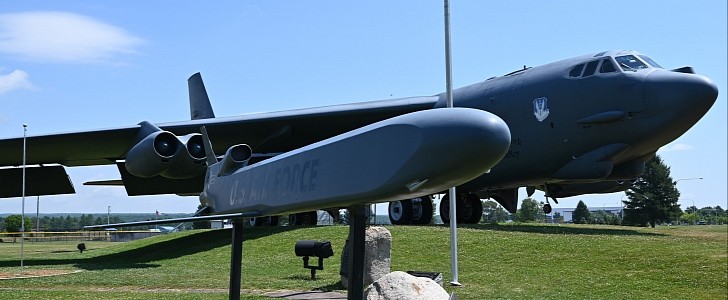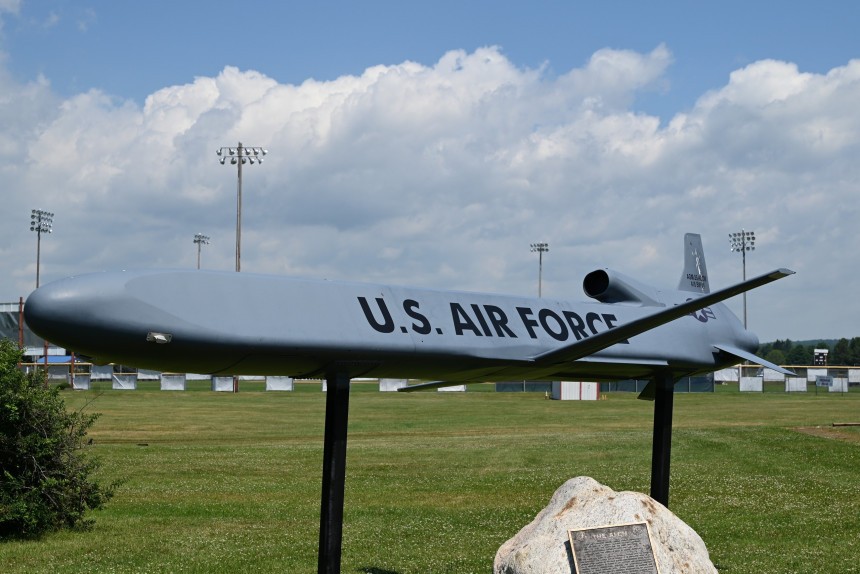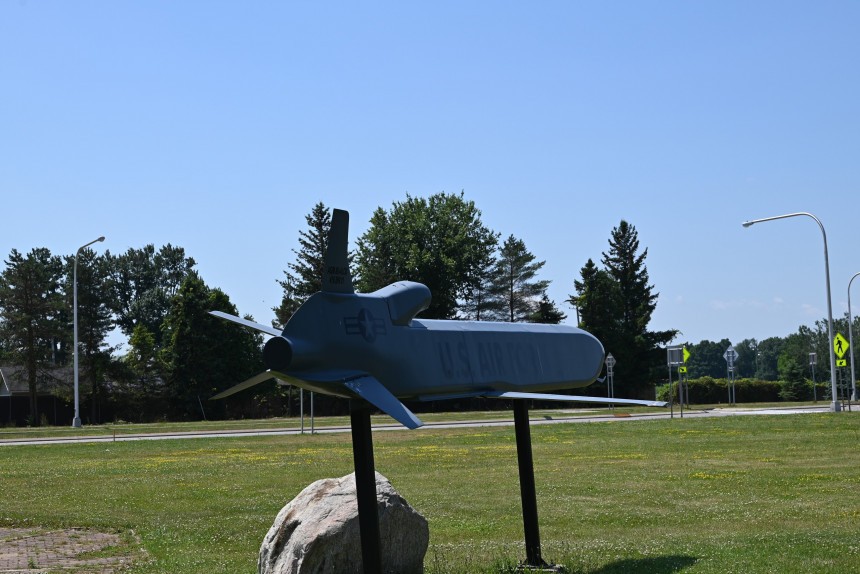You can't talk about modern warfare doctrine without fitting air-launched cruise missiles into the equation. Modern super high-tech cruise missiles can skim across the atmosphere at hypersonic speeds and deliver devastation across a wide area at a moment's notice with almost no conceivable way to defend against it.
But in the early days of air-launched cruise missiles, their top speeds were rather less ambitious. Still, they look pretty cool on display next to the very bomber from which it would have been launched. This is the Boeing AGM-86, one of the first operational American long-range, jet-powered, air-deployed cruise missiles.
Of course, that's somewhat of a debatable claim, as the Ford-Republic JB-2 Loon copied from a German V-1 flying bomb late in World War II is usually bestowed with the title of the first American cruise missile. But let's be honest, it was fairly evident by the end of World War II that pulse jets of any kind were not going to be viable propulsion for a weapon of war.
Though it undoubtedly paved the way for more advanced cruise missiles powered by rockets or turbojet engines, V-1 and JB-2 were more like, well, flying bombs than they were legitimate cruise missiles. In truth, the AGM-86 can trace its roots back to the experimental McdDonnell ADM-20 Quail. The Quale, like the AGM-86, was powered by a small turbojet engine, though it was originally never supposed to be anything like a cruise missile.
Instead, the Quale was designed as a small, cheap, unmanned decoy missile designed to lure enemy surface-to-air defenses into expending precious ammunition. Thus leaving them with a little left over when a squadron of legitimate attack jets legitimately does arrive. But the USAF ultimately discovered that such technology was more practically suited for long-range subsonic ordinance delivery than a swarm dummy airplane.
From the rib of the ADM-20, the first prototypes that would become the AGM-86 platform were born. Though it too was originally intended as a dummy drone, its talents as a cruise missile with an active warhead would soon make themselves apparent. Built by the same company that built the B-52 Stratofortress destined to carry it, the first operational prototype of the AGM-86 as a dedicated air-to-ground cruise missile was first launched from underneath the wing of a Boeing B-52G Stratofortress in March 1976.
With only the bare minimum of radar and sensors arrays necessary for basic flight installed. The more intricate pieces of the ALCM's targeting computer would be installed by September of that same year for more testing. The first operational AGM-86s were ready for operational deployment in December 1982 with the U.S. Air Force's 416th Bombardment Group flying reliable workhorse B-52G and B-52H strategic bombers.
By flying below the speed of sound and relatively close to the ground, the AGM-86 was meant to evade enemy radar and early warning systems by being small and quiet enough to slip through enemy defenses. Powering this nifty little cruise missile was a Williams-International F107-WR-101 turbofan engine jetting 600 lbf (2.7 kN) of thrust.
With a top speed of around 75% the speed of sound and a range of 600 miles, this was surely one of the scarier weapons in the U.S. Air Force's ever-expanding arsenal. Soon the U.S. Navy developed a similar ship-launched cruise missile based on the very same principles as the AGM-86 called the BGM-109 Tomahawk.
Initial plans called for America's shiny new jet-powered cruise missile to fit inside the bomb bay of a slew of different American strategic bombers besides just the B-52. Bombers like the Rockwell B-1 Lancer swing-wing medium bomber and the Northrop Grumman B-2 Spirit stealth bomber were both considered for this role. But ultimately, the sheer relentless reliability of the Stratofortress family meant it, and the AGM-86 had a decades-long love affair.
Moving into the early 90s, a more advanced variant of the AGM-86, the AGM-86C CALCM. The new type would be launched from American B-52s during Operation Desert Storm in 1991, Operation Desert Strike in September 1996, and Operation Iraqui Freedom in 2003. All three times, the missile proved vital in destroying enemy ground targets from long distances and showcased the B-52's virtues not just as a bomber but also as an airborne cruise missile truck.
As many as eight AGM-86 cruise missiles could fit in the bomb bays and under the wings of a Stratofortress. That said, the usual ordinance load would ordinarily consist of no more than two to four warheads. With almost 1,750 AGM-86s leaving the factory floor since 1974, no wonder there are more than a few sitting around in museums.
You're most likely to encounter one at larger, marquee-level warbird museums like the National Museum of the USAF in Dayton, Ohio, or the Steven Udvar Hazy Center in Chantilly, Virginia, among a slew of other museums across the United States.
But right here in beautiful Central New York, right on the grounds of the old Grifiss Air Force Base, you can get up close and personal with one alongside the same B-52 designed to carry it into battle.
Of course, that's somewhat of a debatable claim, as the Ford-Republic JB-2 Loon copied from a German V-1 flying bomb late in World War II is usually bestowed with the title of the first American cruise missile. But let's be honest, it was fairly evident by the end of World War II that pulse jets of any kind were not going to be viable propulsion for a weapon of war.
Though it undoubtedly paved the way for more advanced cruise missiles powered by rockets or turbojet engines, V-1 and JB-2 were more like, well, flying bombs than they were legitimate cruise missiles. In truth, the AGM-86 can trace its roots back to the experimental McdDonnell ADM-20 Quail. The Quale, like the AGM-86, was powered by a small turbojet engine, though it was originally never supposed to be anything like a cruise missile.
Instead, the Quale was designed as a small, cheap, unmanned decoy missile designed to lure enemy surface-to-air defenses into expending precious ammunition. Thus leaving them with a little left over when a squadron of legitimate attack jets legitimately does arrive. But the USAF ultimately discovered that such technology was more practically suited for long-range subsonic ordinance delivery than a swarm dummy airplane.
With only the bare minimum of radar and sensors arrays necessary for basic flight installed. The more intricate pieces of the ALCM's targeting computer would be installed by September of that same year for more testing. The first operational AGM-86s were ready for operational deployment in December 1982 with the U.S. Air Force's 416th Bombardment Group flying reliable workhorse B-52G and B-52H strategic bombers.
By flying below the speed of sound and relatively close to the ground, the AGM-86 was meant to evade enemy radar and early warning systems by being small and quiet enough to slip through enemy defenses. Powering this nifty little cruise missile was a Williams-International F107-WR-101 turbofan engine jetting 600 lbf (2.7 kN) of thrust.
With a top speed of around 75% the speed of sound and a range of 600 miles, this was surely one of the scarier weapons in the U.S. Air Force's ever-expanding arsenal. Soon the U.S. Navy developed a similar ship-launched cruise missile based on the very same principles as the AGM-86 called the BGM-109 Tomahawk.
Moving into the early 90s, a more advanced variant of the AGM-86, the AGM-86C CALCM. The new type would be launched from American B-52s during Operation Desert Storm in 1991, Operation Desert Strike in September 1996, and Operation Iraqui Freedom in 2003. All three times, the missile proved vital in destroying enemy ground targets from long distances and showcased the B-52's virtues not just as a bomber but also as an airborne cruise missile truck.
As many as eight AGM-86 cruise missiles could fit in the bomb bays and under the wings of a Stratofortress. That said, the usual ordinance load would ordinarily consist of no more than two to four warheads. With almost 1,750 AGM-86s leaving the factory floor since 1974, no wonder there are more than a few sitting around in museums.
You're most likely to encounter one at larger, marquee-level warbird museums like the National Museum of the USAF in Dayton, Ohio, or the Steven Udvar Hazy Center in Chantilly, Virginia, among a slew of other museums across the United States.

























